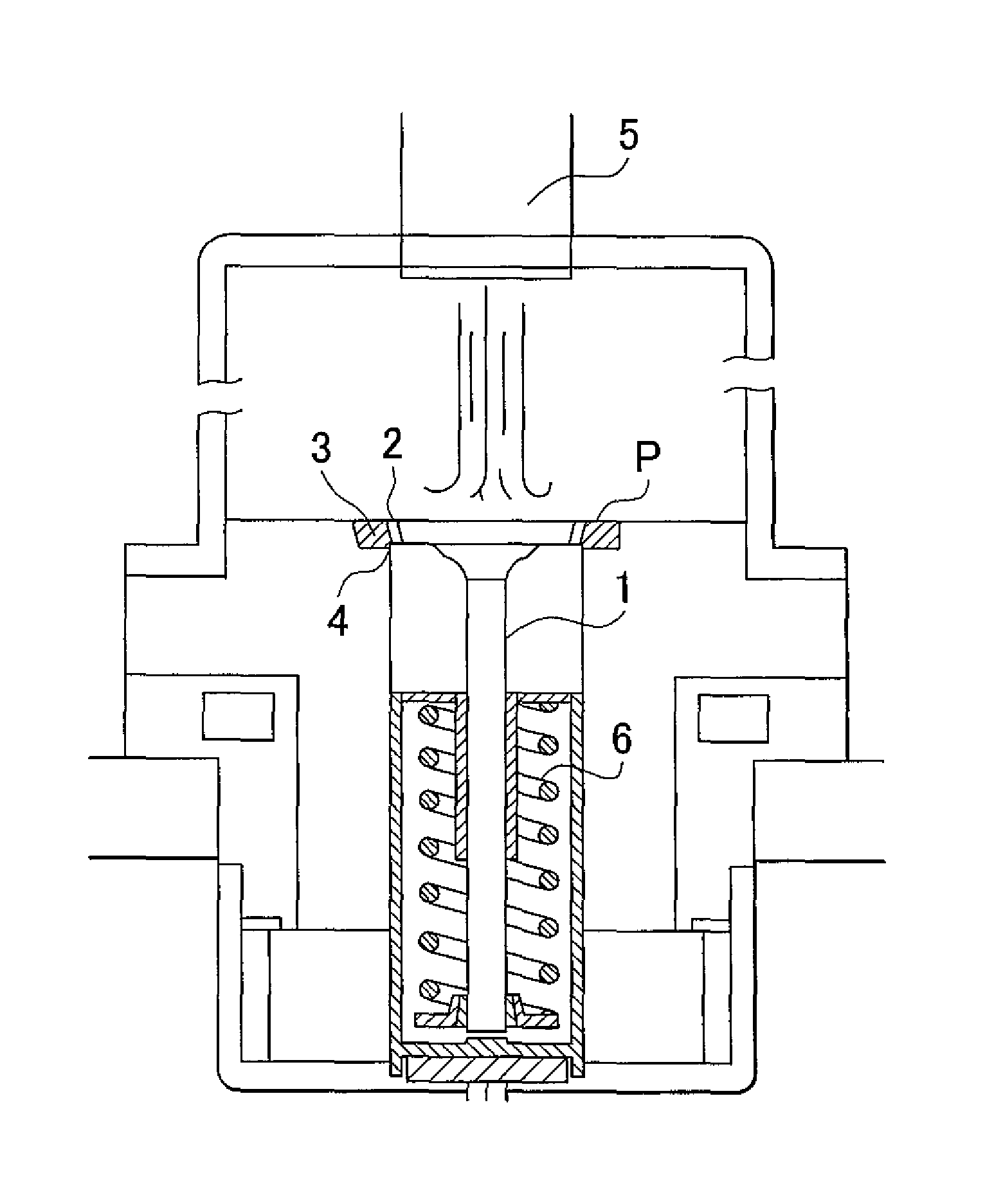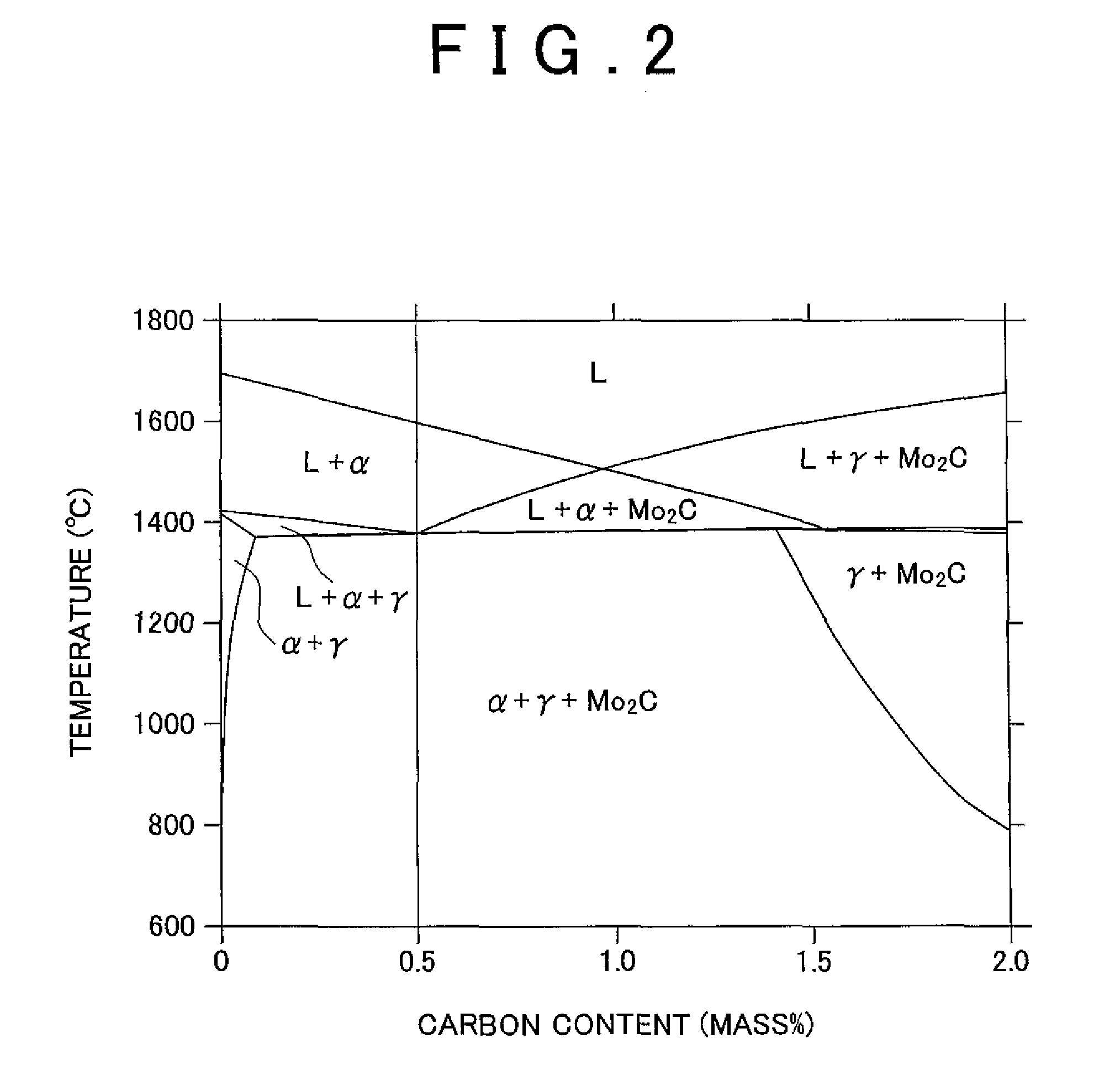Cladding alloy powder, alloy-clad member, and engine valve
a technology of cladding alloy and alloy, which is applied in the direction of machines/engines, metal-working devices, metal-layered products, etc., can solve the problems of reducing not having a satisfactory toughness, and not adequately exhibiting the properties of heat-resistant steel typically used as a valve material, so as to improve the toughness improve the wear resistance of the cladding alloy. , the effect of improving the toughness
- Summary
- Abstract
- Description
- Claims
- Application Information
AI Technical Summary
Benefits of technology
Problems solved by technology
Method used
Image
Examples
example 1
[0041]A cladding alloy powder that satisfied the content conditions of C: 0.7 to 1.0 mass %, Mo: 30 to 40 mass %, Ni: 20 to 30 mass %, Cr: 10 to 15 mass %, and balance including Co and unavoidable impurities, was first prepared as a cladding alloy powder corresponding to an example of the invention.
[0042]Specifically, a cladding alloy (alloy in which Co formed the matrix) with the composition C: 0.9 mass %, Mo: 30 mass %, Ni: 20 mass %, Cr: 10 mass %, and balance including Co (Co: at least 35 mass %) and unavoidable impurities, was melted at a temperature of at least 1700° C. and a cladding alloy powder was produced using a gas atomizer in which an inert gas is used. This cladding alloy powder was classified into the 44 to 180 μm range. A Co-30Mo-10Cr-20Ni-0.9C cladding alloy powder was obtained as a result.
[0043]The 1.0 mass % upper limit for the C content in the cladding alloy powder was established as follows. Specifically, a phase diagram in which the C content was varied, as ex...
example 2
[0045]A cladding alloy powder that satisfied the content conditions of C: 0.2 to 0.5 mass %, Mo: 30 to 40 mass %, Ni: 20 to 30 mass %, and balance including Co and unavoidable impurities, was prepared as a cladding alloy powder corresponding to an example of the invention.
[0046]Specifically, a cladding alloy (alloy in which Co formed the matrix) with the composition C: 0.5 mass %, Mo: 30 mass %, Ni: 20 mass %, and balance including Co (Co: at least 35 mass %) and unavoidable impurities, was melted at a temperature of at least 1700° C. and a cladding alloy powder was produced using a gas atomizer in which an inert gas is used. This cladding alloy powder was classified into the 44 to 180 μm range. A Co-40Mo-20Ni-0.5C cladding alloy powder was obtained as a result.
[0047]Using the previously indicated Thermo-Calc integrated thermodynamic computation system, the 0.5 mass % upper limit for the C content in the cladding alloy powder was established, as in Example 1, from a phase diagram in...
examples 3-1 and 3-2
[0064]Engine valves clad (overlaid) with the cladding region and test specimens for hardness testing were fabricated proceeding as in Example 1. The differences from Example 1 were as follows: a C content of 0.7 mass % was used in Example 3-1 and a C content of 1.0 mass % was used in Example 3-2.
PUM
| Property | Measurement | Unit |
|---|---|---|
| mass % | aaaaa | aaaaa |
| mass % | aaaaa | aaaaa |
| temperature | aaaaa | aaaaa |
Abstract
Description
Claims
Application Information
 Login to View More
Login to View More - R&D
- Intellectual Property
- Life Sciences
- Materials
- Tech Scout
- Unparalleled Data Quality
- Higher Quality Content
- 60% Fewer Hallucinations
Browse by: Latest US Patents, China's latest patents, Technical Efficacy Thesaurus, Application Domain, Technology Topic, Popular Technical Reports.
© 2025 PatSnap. All rights reserved.Legal|Privacy policy|Modern Slavery Act Transparency Statement|Sitemap|About US| Contact US: help@patsnap.com



